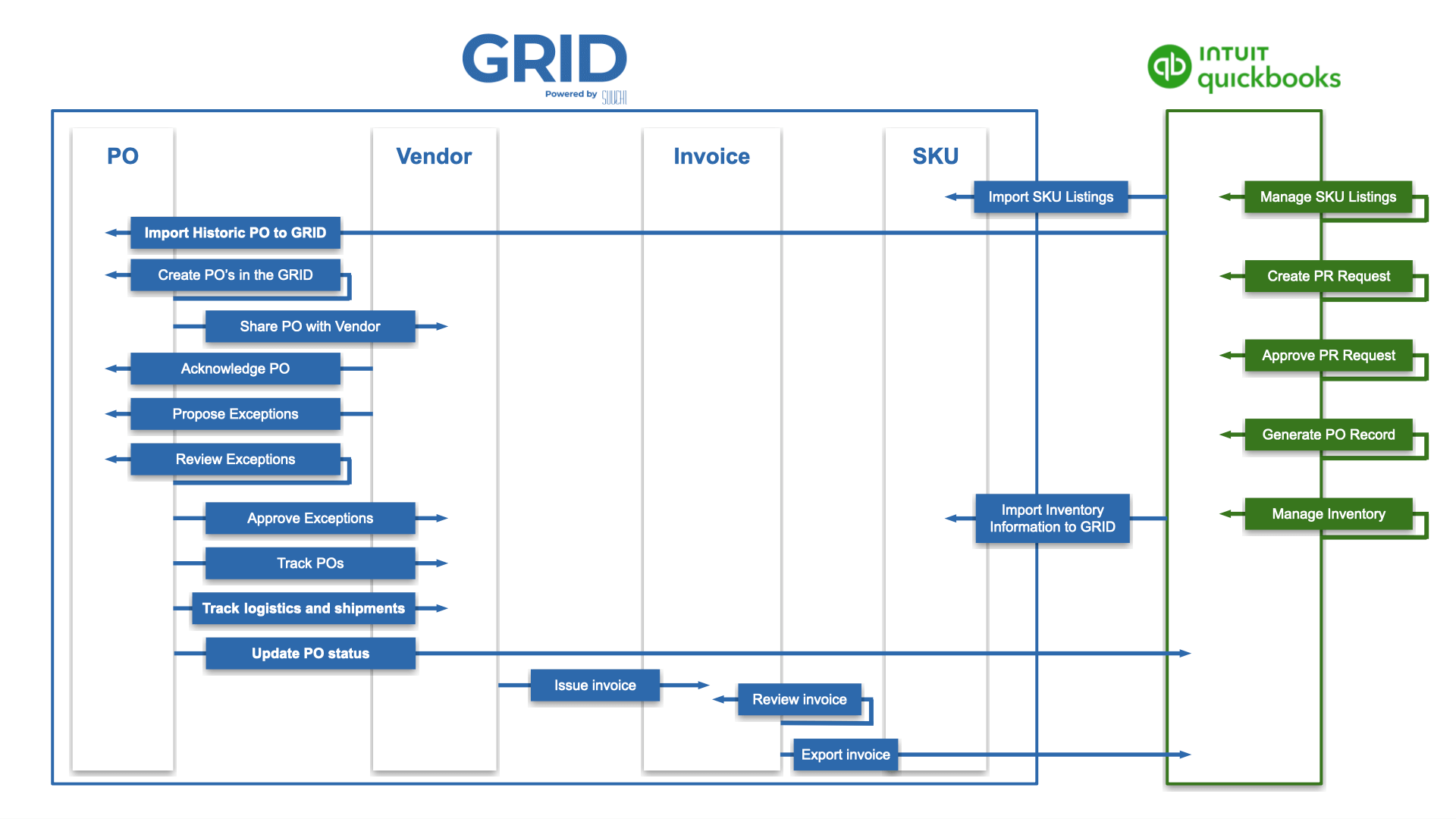Our GRID team loves Quickbooks for many reasons. For tens of thousands of fast growing companies across retail, e-commerce, manufacturing, distribution, industrial, services and countless more industries, Quickbooks provides an accessible and scalable accounting and financials system. When we encounter Quickbooks, it often means the rest of the company’s supply chain across product, vendor, and order data is being run on excel sheets and emails. In these instances, the GRID enters as the product, vendor and order master – i.e., as the company’s first PIM, Sourcing Management layer, and ERP system – while integrating with Quickbooks for payments reconciliation, invoice management and thereby ensuring financials’ data accuracy and connected data for better decision making.
Data Synchronization and GRID Quickbooks Integrations Overview
The GRID integrates with QuickBooks, pushing and pulling data across purchase orders, invoices, payments, item masters, inventory levels, and financial transactions.
The GRID platform is an operational layer that allows organizations to manage their day-to-day workflows effectively in conjunction with financials information managed in Quickbooks. Some of the key productivity functions that are managed on GRID while connecting with Quickbooks include –
- Fetching sales orders and information from Electronic Data Interchange (EDI) systems for businesses operating in various industries, particularly those involved in supply chain management, logistics, manufacturing, and retail. Margins for sales orders are managed and tracked on the GRID. The sales orders are flipped to purchase orders to vendors, with real time recording and mapping of vendors and items based payment terms and deposits. All this information across sales and purchase orders, margins, payment terms and reconciled invoices are pushed to the GRID for accurate financials’ tallying.
- Creation and management of purchase orders to manage transactions with suppliers and other supply chain participants are managed on the GRID. This eliminates the need for manual paperwork, phone calls, or emails, enabling faster order processing and reducing delays associated with manual processes. Any exceptions generated by the factory or freight forwarder in lead times, costs or quantities are flagged and managed on the GRID. Exceptions impact payments due to vendors. Reconciliation of actual versus issued quantities, along with discounts for delays are recorded and pushed to Quickbooks to update financial records.
- The GRID provides real-time visibility into the status of orders, allowing both buyers and suppliers to track order progress, monitor inventory levels, and anticipate delivery timelines more effectively. Where there are changes in orders’ delivery timelines or inventory levels that impact financials’ reconciliations, such updates are pushed to Quickbooks.
- The GRID integrates with ecommerce and retail selling channels and pushes both micro level and aggregated sales order information into Quickbooks.
- The GRID digitizes invoice creation and management to help businesses streamline the entire invoicing process, reducing manual effort and administrative burden. Automated and reconciled workflows pushed to Quickbooks enable businesses to generate invoices quickly and accurately, send them to customers electronically, and track their status in real time.
Benefits of GRID Quickbooks Integration
Automation
Integration allows for automation of key processes, reducing manual data entry and the risk of errors. For example, when a purchase order is created on the GRID, it can automatically generate corresponding entries in the Quickbooks accounting system, updating accounts payable and inventory records.
Real-Time Visibility
Integrating GRID and QuickBooks provides real-time visibility into inventory levels, costs, and financial performance. This enables better decision-making by allowing stakeholders to access accurate and up-to-date information whenever needed.
Streamlined Processes
GRID and Quickbooks integration streamlines workflows by eliminating the need for redundant data entry and manual reconciliation between systems. This improves efficiency and productivity across the organisation, as employees can focus on value-added tasks rather than administrative work.
Accurate Reporting
By consolidating data from GRID and QuickBooks, businesses can generate comprehensive reports and analyses that provide insights into operational performance, cost drivers, profitability, and other key metrics.
In summary, digitising and connecting GRID and Quickbooks systems across the creation and management of purchase orders and invoices offers significant advantages in terms of efficiency, accuracy, visibility, cost savings, and compliance. Through this integration, our customers have modernised their procurement processes, improved productivity, and gained a competitive edge in today’s digital marketplace.

Ketan Anand
CPO
Suuchi Inc
Suuchi Ramesh
Founder, CEO
Suuchi Inc
To find out more about our integrations please visit www.suuchi.com or write us at hello@suuchi.com
